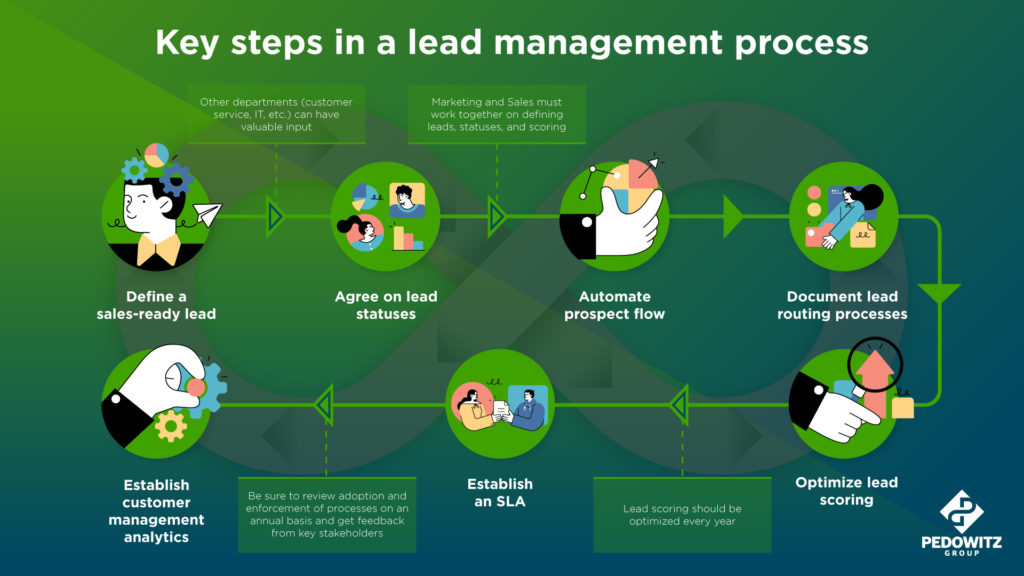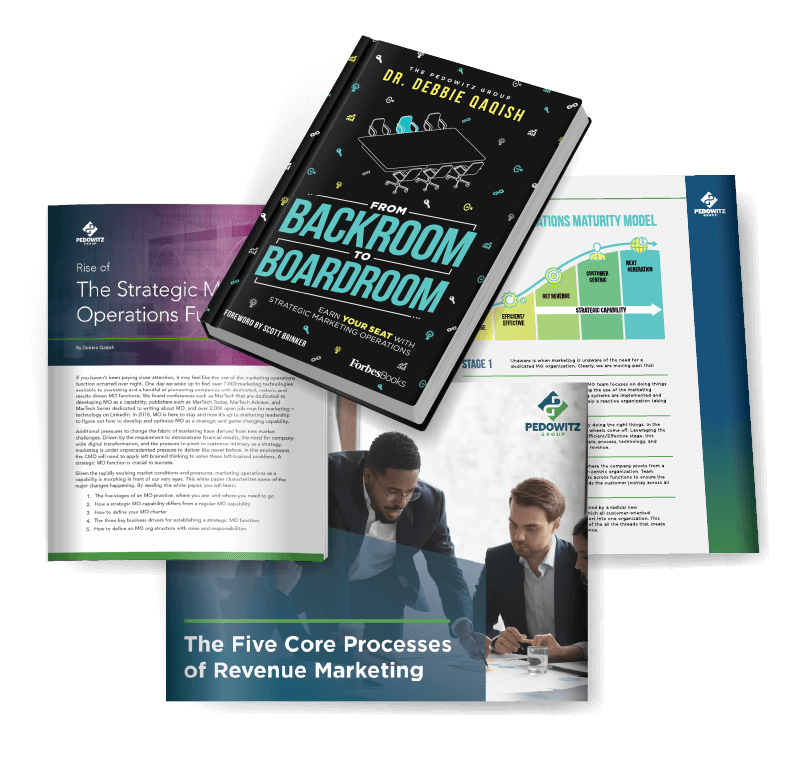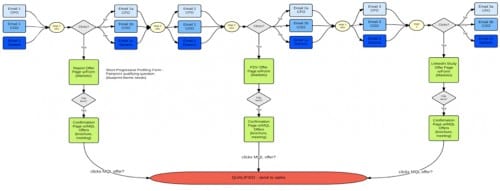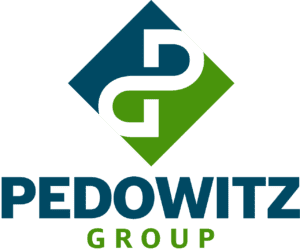In a post looking at a modern marketing team, we covered elements of an organizational structure for a revenue marketing center of excellence. But if your teams don’t master critical marketing processes, it’ll all be for naught!

If you’re lucky enough to have a dedicated marketing function at your organization, then you know that an important part of their job is in defining, documenting and refining the core marketing processes that keep teams and systems running well.
Let’s narrow the discussion to the top five processes (click to jump to that section) – and get into what each really means for your organization:
1. Lead Management Process
The lead management process outlines the steps for tracking and reporting on leads as they are created and move through a funnel, becoming qualified or disqualified, and eventually passing through any lead development representatives to sales or channel partners.
A typical process includes the following components:
- Definition of a sales-ready lead
- Definition of the various lead statuses in the CRM defined funnel
- Design of the lead processing, routing, and related notifications
- Design of the lead scoring algorithm
- Development and agreement to a service level agreement between sales and marketing
- Establishment of funnel metrics
Without these established and enforced, you’ll simply leave money on the table because opportunities aren’t properly acted upon.
This is a hugely important marketing process, and one that is the root cause of so much lost revenue!
Why? Because it outlines the steps for tracking and reporting on leads as they are created and move through a funnel. During this process leads become qualified or disqualified, and eventually pass on to a lead development team and finally onto sales or channel partners.
A typical process includes the following components, and you can read more about each in our blog diving into lead management:
- Definition of a sales-ready lead
- Definition of the various lead statuses in the CRM defined funnel
- Design of the lead processing, routing, and related notifications
- Design of the lead scoring algorithm
- Development and agreement on a service level agreement (SLA) between sales and marketing
- Establishment of funnel metrics
Related: Our lead management consulting services uncover and fix any issues!

2. Reporting and Analytics Process
The defines who will report on what, when, and for whom. Where will they get the data, and how will the reports be made available?
Before you raise your eyebrows to the ceiling and slam me for stating the obvious, consider that the resources for doing reporting in mid-sized organizations are usually limited, and so often the function is decentralized. (I.e., many marketing field offices report on their piece only.)
Without some defined process, templates, definitions, rules, and handholding, your ability to roll up the reports will be either laborious or impossible!
A thorough analytics marketing process features:
- Data sources: defined for all the different data or activity types
- Report frequency: report timing based on the decision-making needs related to that data
- Owner assignment: Identifying authors and the folks who run the reports
- Standards: Report presentation norms for different types of reports
- Media: to be used for delivering and presenting reports (CRM, MAP, Excel, BI, PPT, etc.)
- Distribution: How to subscribe, unsubscribe, access reports
- Modifications: Who to call to get new or modified reports
- Archival: Where all past reports be housed
Most firms, when they first dip their toes into the results reporting waters, look to report on their funnel results which depend entirely on having a functioning lead management process.
But before you can start, you need these two definitions:
- Activities Reports: opens, clicks, visits, CTRs, visitors, duration, bounce, deliverability, etc.
- Results Reports: New leads, MQLs, SQLs, opportunities, renewals, new customers, bookings, Revenue, CLV
As a CMO, I don’t have much time for activity reports; I need to understand how my department is impacting revenue on a regular basis. This means I need useful reports.
So, what constitutes a useful report?
- Clear, agreed-upon metrics from the top-down on what’s important to measure
- Easily-digestible reports that clearly communicate these KPIs
- Ensure everyone interprets the data in the same way. Having the report be as simple as possible helps with this.
Getting teams to the point of analyzing the data and making data-based decisions on a daily basis will not happen just organically. Leadership has to lead in this practice and drive it down into the organization.
Provide the training and resources necessary to bring the team up to speed and allow time for the organization to acclimate to these new expectations. It’s a satisfying experience to attend a marketing status meeting and hear the broader team excitedly talking about changing their immediate plans based on last week’s or last month’s significant shift in a trendline!
Related: Build useful, scalable reports with our Excel for marketers course!
3. Data Management Process
No, this is not solely the job of IT or sales. It absolutely includes marketing as both a customer of the data and a provider of much new data!
The best way to corrupt a perfectly-fine CRM database is let an untrained person in marketing or sales, with no enforced process, do a 100K contact data import into their marketing automation platform and have it sync over to the CRM.
From a marketing process perspective, here are some of basic must-have components for your data management:
- List import process and designated, trained, importers
- Rules for all forms (required fields)
- Normalization guidelines for lists and form data
- Governance — defined authorization for what marketing can and cannot do
As the old adage says: Garbage in, garbage out! This is an often-overlooked (or ill-defined) need that we’ve seen so many companies struggle with.
Add Data Operations To Accelerate
If content is the fuel, and analytics is your dashboard, then data is surely the wheels and tires on your marketing vehicle. There’s an adage in auto racing that races are won in the pits, and the tire changes that happen there affect the race strategy and must be suited to the course.

Similarly, your data will dictate where you can go, and how fast you can get there. It will be impossible to become a data-driven marketing organization if the data quality is poor. Having a resource in marketing who is responsible for data operations is becoming a requirement for successful marketing.
Marketing data is fragmented and getting more so every day. Research by Experian uncovered that 84 percent of organizations are experiencing data quality issues. Compounding these issues is the explosion in marketing technologies (to the point Scott Brinker’s supergraphics have become quite insane!), which further fragments data.
So, the importance of clean data is increasing.
In larger organizations, marketing operations will likely have a data operations resource. Their responsibilities include:
- data quality management
- CDP
- database operations
- marketing intelligence
- data architecture management
- data acquisition and enrichment
This resource will not need to address the areas covered by the broader IT organization:
- business intelligence system deployment
- master data management (MDM)
- data security management
- document and content management
- data storage management
At a very tactical level, the data operations person will own the data import and enrichment processes. They will be responsible for the right data being available in the right marketing system, which will ensure effective marketing execution and great customer experience with marketing digital properties.
4. Campaign Development Process

One might ask, why do I need a campaign development process? In truth, if your campaigns look like a linear flowchart in their execution, you may not need a built-out process because your marketing isn’t mature enough to warrant it.
But what if your campaigns involve multiple touchpoints and plenty of complexity? Think offers, landing pages, ad copy, graphics, emails, etc.
To coordinate this and launch flawless campaigns you need a defined campaign development process that outlines the roles and expectations for every player involved. Your campaign development process, however simple, will probably contain these stages and definitions for how the campaign transitions from one stage to the next:
- Concept
- Design
- Development
- Testing
- QA
- Deploy
- Report
The strategy stage is where the program or campaign is proposed, the costs and benefits are weighed, and if approved, it moves to the design stage.

During the design stage, the campaign brief, potentially a creative brief, and ultimately the detailed campaign blueprint are created.
While the campaign brief is a simple, one-page document that describes the campaign, the blueprint is the document that you hand off to your marketing automation platform campaign builders. It contains every detail they will need to build, test and launch the campaign. It has every requirement in it, including dynamic content rules, A/B testing, campaign flow, timing, templates to be used, URLs desired, channels, offers, UTM codes, etc.
In general, we recommend you don’t move into the development stage until the blueprint is complete and all the assets, offers and content are ready. Changing the blueprint (aka the requirements) after development has started will cause rework, slow the campaign down, affect other campaigns in the queue for building, and increase the risk of errors.
Quality assurance (QA) and user acceptance testing (UAT) are vital. Please do not discover this for yourself by sending an error filled email to 100,000+ people. Builders, especially neophytes in your MAP system, are allowed to make mistakes, but QA has to be flawless so use your senior people to do the QA.
5. Content Development Process
Content operations is responsible for the optimization of all things content including strategy, ideation, storage, curation and measurement housed in a central location and supported by a content operations platform. A core value of content operations is the streamlining of content development and production.
The content development process is likely to have components such as:
- Content calendar: location, owners, updates, communications, and alignment to campaign calendar
- Subject Matter Experts (SME) identification, documenting their expertise, preferred medium and availability
- Content architecture: lists and management of all the things that have to be developed in addition to the core content in order to promote it such as email, landing page, and blog copy; graphics, ad copy, display ads, etc.
- Requirements for content engagement tracking and reporting
To avoid the chaos and spend your budget wisely, you will be well served by organizing your content operations along these lines:
- Strategy — Start with the demand gen plan and the customer lifecycle (buying journey) and work backwards to a content plan. Do not start with the product/service and go forward.
- Ideate — Provide a central location to share and house ideas across the firm.
- Produce — Provide one or more centralized functions for planning and production of content, publishing content calendars, streamlining the production process and driving brand alignment.
- Publish — Have a plan for all the channels you want to support and the content formats needed. Coordinate release of content on different channels. i.e. the blog folks should know what the social team and inbound team are doing, as should the email campaign folks and the sales enablement team.
- House — Provide a central location for all content. Make it easy for sales and channel partners, as well as remote marketing folks to browse the library by topic, format, campaign suitability, and success at driving prospect and customer engagement.
- Curate — Don’t just leave content sitting on the digital shelf. Retire old content, splinter new content, figure out all the places it can be used — audience and channel. Someone should own maximizing the use of these assets.
- Measure — Most importantly, don’t forget to measure content effectiveness above and beyond impressions. I.e. measure engagement, and influence on your pipeline.
Next Steps
So, those are my top five Revenue Marketing processes that your team absolutely has to master. Would you prioritize something else higher than one of these? Are you attending to all of them today?
If you want to drive necessary change in your organization, our Revenue Marketing Bundle is exactly what you need!
If you’re missing one or more of these, here’s the priority order I would recommend for getting basic coverage in all of these areas:
- Tackle lead management first. It doesn’t have to be perfect, but if you don’t have some process here how can you track marketing influence on revenues? If you cannot show marketing impact on the bottom line yet, nothing else is going to matter.
- Tackle data management as soon as possible, maybe in conjunction with lead management. Once you start the reporting, you”ll see all the holes in your existing processes, and the quality of the data. With poor data all your campaigns and content will be for naught. This is not a one-time effort … it is a discipline! Put the processes in place to keep the data clean and monitor and report on data quality regularly.
- Reporting and analytics. Don’t expect what you don’t inspect, right? Put in place the basic reporting to help your marketing managers make better decisions and spend your program budget wisely. Do not start with the marketing vanity reports.
- Get going on a simple content development process. New, great content takes longer to develop than most folks realize. Start the content calendar immediately so you can line up the resources and get specific content development into their quarterly goals!
- Treat campaigns just like you would product development. Create a product development lifecycle for campaigns, train some project managers specifically for doing multi-channel campaign project management. If you are at a larger firm, get a traffic manager to help with all the content – don’t burden the campaign project managers with it. If you want flawless campaigns, train up a core team in the campaign development process, and direct all campaign work to them.
Need help? We’re here for you, but in the interim, I wish you the best as you upgrade these five core marketing processes to drive greater wins and revenue for your organization!
Want more? Start your revenue marketing evolution with this blog!
